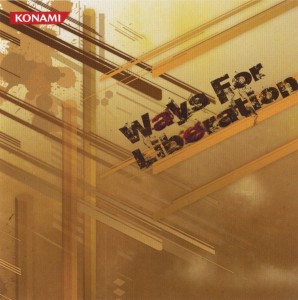Ways For Liberation
 |
Album Title: Ways For Liberation |
| Record Label: beatnation Records |
|
| Catalog No.: LC-1891/2 |
|
| Release Date: March 24, 2010 |
|
| Purchase: Buy at Amazon.co.jp |
Overview
Ways for Liberation is the first album by Kosuke Saito of his Bemani works on the beatnation Records label, though he has previously released his Bemani works albums under avex trax. Like other releases on the label, the album contains two discs with the first containing Saito’s original material, but unlike the previous albums, the second disc does not exclusively feature remixes of Saito’s works by other Bemani artists, but includes in addition old and new collaborations with other Bemani artists.
Body
The first disc begins with a newly penned introduction, leading into Saito’s more melodic output. “Intro” itself is fairly sparse at first, focusing on a female voice who introduces the album. It’s all a bit cheesy and hyperbolic, but thankfully its short. The first full track is a studio version of “SigSig” as performed at beatnation summit. The arrangement is very similar to the original, and most of the changes come from a new instrumental sections, and a small change in the main synths. It doesn’t altogether feel that different, but it’s a strong track and is decently fun. Also in this section is the Hardcore mix of “Smooooch・∀・”, which doesn’t actually sound all that different from the original (since it is mainly backing elements that are switched up), which is a shame because the original is not one of Saito’s stronger works. “Dirty Digital” is a great track from this section that takes its time building up to the strong melody, but it is a tad too bulky for its content. There other tracks in this section have vocals. “Rising in the Sun” and “Horizon” both have great melodies and energetic hardcore arrangements, and they are among my favourite tracks on the album, through the former is certainly overlong in this extension. “Horizon” on the other hand is more dynamic in its extensions, and also has some new instrumental work written for it. “D” did not originally have lyrics, and although Tim’s voice doesn’t quite fit the track, it’s not a terrible addition and it justifies the extended track length. The heavier instrumental track “Oarfish” contrasts the harsher accompaniment to a beautiful melody, and I like the reduction down to simpler instruments that leads into the next part of the album.
“Interlude Concourse A” is a short bit that starts the second segment of the album, which features the more aggressive styles of music and defocus on melody compared the previous segment. “Programmed Life” is a fantastic psy trance track in this vein, but its a shame that it is only the game version with no changes. Unfortunately the rest of this section doesn’t hold up as well, all being bit too long and repetitive, feeling mostly like filler. That’s not to say that it’s not enjoyable filler, as with “Bad Maniacs” and the stronger electronic influence in this version of the track in addition to the industrial rock, helped by a strong bassline. The gabba “Ay carumba!!!!!” has an interesting and misleading new strings opening, but it has been stripped down a bit and is overall not as busy or interesting as the extended version from teranoid anthems. “Evergreen” and “Programmed Sun” are a bit less oppressive in sound, but they are both far too long, which is a shame for the former which boasts a great melody and an exotic feel at its main melody, but the track takes four minutes to reach that point and then quickly glosses over it. Perhaps it would have been better if all of these tracks were their original game size, since the added filler really detracts from them.
“Interlude Concourse C” leads into the final stretch of the first disc. The interlude itself is enjoyable, with a bubbly atmosphere. “Connected” is a new atmospheric trance track with a lot of improvised piano throughout, and vocalist Rire speaking over the track. Her English is rather bad, but it’s still a very enjoyable journey with lots of movement throughout the song and a shifting soundscape. “Special One (Dreamin’ Of You)” is the only ballad of the album, with vocalist Suzuyo Miyamoto. Rather than the original house accompaniment, here the track features mostly light piano work and a bit of strings later on. It’s not a very raw ballad by any means, but the melody is pleasant enough and the second verse is welcome. “Outro” closes out the first disc with a light space-y atmosphere with some echoing piano and blips here and there. It doesn’t do much, but its nice enough.
The second disc begins with a set of collaboration tracks. “Bleep Code” is a new track with Ryutaro Nakahara, with Nakahara’s side coming through in the brighter melody and upbeat sound. Unfortunately the track is repetitive as Nakahara’s tracks tend to be, though it’s not as bad as the new track with L.E.D., “Emission High Energy”. The drum’n’bass in this latter track is executed well enough, but the same short motif is played over and over throughout and it becomes rather grating. “Film”, the new track with Slake, fares much better, benefitting from Slake’s quirks and an evolving sound throughout that keeps things interesting. Saito’s lower synths are a great complement to Slake’s more spacious ambiences, resulting in a highlight track. The existing collaborations are quite good too. “Decade” is very clearly a collab with Takayuki Ishikawa, with his signature synths, melody, and piano runs throughout. A bit run-of-the-mill, but enjoyable trance that is beefed up a bit thanks to Saito’s contribution. “Juicy” with DJ Yoshitaka is a male J-pop track with a bright melody and arrangement, and vocals that are heavily processed. It can be over-the-top at times, but the positive nature of the track is undeniably charming. “Now and Forever” is another strong trance J-pop track, albeit a bit overlong now with the extension. Saito also does his own new mix of his collab with DM Ashura, “Your Angel” making the accompaniment more varied, much improving the track. However, it’s still far too cheesy for my liking, and I often skip it.
The remaining tracks are remixes of Saito’s tracks by other artists, and they are for the most part very great. Sota Fujimori does a great “Programmed World”, remaking the track with his signature synths, and glitching the track up here and there. It all works great for the song, and I actually like it much more than the original, even with Fujimori’s strange added female vocal samples. Shu Okyuyama’s “Love is Eternity” is very far removed from its source material, almost unrecognizable. It now takes a tropical house sound with some hazy guitars and synths, but its uniqueness doesn’t save it from its meandering pace. Remo-con does a great job at filling out “The Shadow” with tribal house elements, greatly elevating the original track which was pretty bland. AKBK’s “Smooooch・∀・” also has a great mix of new sounds that improves on the original, from euro to chiptune and a bit in between as well. The “Rakuen” and “Sunshine Hero” remixes actually switch out the unique palettes of the originals for a more typical electronic sound that actually sounds more like Saito’s usual output than anything, but it works well for the tracks. Finally, NekomataMaster’s “Clione” remix was one of my most anticipated, but unfortunately the track hides the main melody of the song behind a jumble of instruments and takes away a decent amount of the wistful original. It’s still nice to listen to as all NekomataMaster tracks are, but it does feel a bit disappointing. But overall the remixes are fairly strong, and do a good job of rounding out the second disc.
Summary
Ways for Liberation is a rather mediocre album from Kosuke Saito, having some strong tracks but marring most others with an excess of filler and a bit of unevenness. The first disc has a good selection of Saito’s various styles, and it all comes together well enough in a single energetic disc, but most times it is mind numbing and too repetitive. The second disc feels stronger though less cohesive, and some of the remixes are great at livening up Saito’s weaker tracks. Overall it works well enough as background pump-up music, but it isn’t quite engaging enough outside of that and tends to be quite bland. It might satisfy fans of Saito’s work, but there’s a lot of missed potential here.
Do you agree with the review and score? Let us know in the comments below!
2.5
Posted on November 13, 2015 by Christopher Huynh. Last modified on November 13, 2015.














